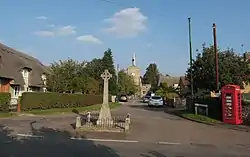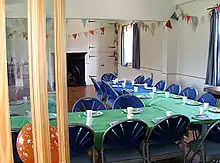Hinxton
Hinxton is a village in South Cambridgeshire, England.
| Hinxton | |
|---|---|
 Village centre: memorial cross, mini-library in a red telephone box, and the parish church | |
 Hinxton Location within Cambridgeshire | |
| Population | 320 |
| OS grid reference | TL496450 |
| Shire county | |
| Region | |
| Country | England |
| Sovereign state | United Kingdom |
| Post town | SAFFRON WALDEN |
| Postcode district | CB10 |
| Dialling code | 01799 |
| UK Parliament | |
The River Cam runs through the village, as does the Cambridge to Liverpool Street railway, though the village has no station. Hinxton parish's southern boundaries form the border between Cambridgeshire and Essex. The village is five miles (8 km) north-west of Saffron Walden and nine miles (14 km) south of Cambridge. The 2001 population was 315.[1]
Hinxton is the home of the Wellcome Trust Genome Campus, which includes the Wellcome Trust Sanger Institute and the European Bioinformatics Institute.
History
The name Hinxton is a contraction of Hengestestun, "the town of Hengest".[2]
The village of Hinxton is listed in the Domesday Book of 1086 as Hestitona, as Hyngeston in the Ely Registers of 1341 and Hengestone in the Ramsey Chartulary. Its parish church is the medieval St Mary and St John Church.
Hinxton Hall
Hinxton Hall, set on an estate of 95 acres (380,000 m2) on the banks of the River Cam, is a red-brick building built in the eighteenth century. Since 1992, the hall has been occupied by the Wellcome Trust Genome Campus and has housed their pioneering genome-sequencing project.[3]
History
The first house on the site of the hall was a modest hunting lodge built by Joseph Richardson of Horseheath in around 1740, before being sold to Thomas Brown of Ickleton in 1748, passing into the possession of his great-niece Mary Holden. Holden's first husband John Bromwell Jones pulled down the original house and built the present hall between 1748 and 1756. Subsequent owners extended the property and land.[4]
In 1953, the owner, Col. R. P. W. Adeane of Babraham, sold the hall and estate to Tube Investments Ltd. for use as research laboratories, and new buildings were added on the grounds as laboratories.[4] In 1992, the hall was taken over by the Wellcome Trust.
Hinxton Mill
Hinxton Mill straddles the River Cam as it flows northward through the village. Although the present mill was built in the seventeenth century, it is almost certainly the site of the mill mentioned in the Domesday Book of 1086.
The mill, used for grinding corn, ceased operation in 1955 and fell into disrepair until being restored in the 1980s with help from Cambridge Past, Present and Future who now own the building; it is open to visitors on about six days per year.[5]
Hinxton Village Hall

The flint and brick building lies at the heart of the village, and dates back to Victorian times. Its community role began when the oldest part of the hall was opened as a reading room for villagers, a place to meet and keep up with the news and share books. Generations of Hinxton residents have cared for the building and over the last five years it has undergone a programme of sympathetic updating – to combine the best of traditional village life with modern amenities.

The village hall is in the High Street, next to the recreation ground. It can be hired for family parties, business and commercial events.[6]
Village life
The village is home to the Red Lion public house, a seventeenth-century building that has been in use as a public house since at least 1841, though there are records of an inn in Hinxton in 1744.[4]
See also
References
- "Hinxton" (PDF). Census. 2001. Archived from the original (PDF) on 9 June 2011.
- Rev. Walter W. Skeat (1901). The place-names of Cambridgeshire. Cambridge Antiquarian Society.
- "History". Wellcome Trust.
- "Parishes: Hinxton, A History of the County of Cambridge and the Isle of Ely". British History. 1978.
- "Hinxton Watermill". CambridgePPF. Archived from the original on 20 April 2011. Retrieved 11 April 2011.
- http://www.hinxtonvillagehall.co.uk
External links
![]() Media related to Hinxton at Wikimedia Commons
Media related to Hinxton at Wikimedia Commons
